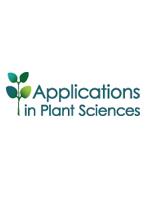The plant sciences are now facing an unprecedented time in our history in which technology is advancing at a rapid pace, creating a wide variety of novel opportunities for our field. Applications in Plant Sciences is a new source for sharing exciting and innovative applications of new technologies that have the potential to propel plant research forward into the future.
Welcome to the inaugural issue of Applications in Plant Sciences (APPS), a premier source for sharing exciting and innovative information with the potential to facilitate and transform research across the plant sciences. More so than at any other time in the history of our field, we are in the midst of a technological revolution, spurred in part by rapid advances in computerization and online networking. For example, the growth of relatively new research areas and tools such as bioinformatics and geographic information systems (GIS) have become possible in part because of substantial advancements in computing power and storage capability. In addition, handheld devices such as smart phones and tablets now enable instantaneous communication among scientists—something unheard of 200 years ago when handwritten letters were the only means of correspondence. We can only expect these technological advancements and their applications to continue at a growing pace in our increasingly connected world. As plant scientists, we must harness these technologies and discover new ways they can enrich our own research activities and those of our field. Just as the invention of the microscope and the development of PCR revolutionized science, so too may some of the technical achievements being created today.
We must now work together to share new developments based on these advances that have the potential to propel our field forward. Scientific progress does not occur in a vacuum but rather is built upon the past historical achievements of others with a splash of our own ingenuity and input from experienced colleagues. The opportunity for such dialogue has never been greater than at the present time, given today's rapid expansion of online communication resources. To this end, APPS has been designed as an open-access journal with continuous publication in which articles will be published online as they are accepted. This will facilitate accessibility for researchers around the world and will expedite the dissemination of innovative information encompassing all areas of the plant sciences, including but not limited to genetics, structure, development, evolution, systematics, and ecology. The journal already has a strong record for publishing molecular markers, reflecting its origin in 2009 as an online-only section of the American Journal of Botany, AJB Primer Notes and Protocols in the Plant Sciences. Now expanding to address all areas of the plant sciences as an independent journal, APPS is positioned to cover a wide variety of research needs by publishing novel protocols and primers, software notes, reviews, and application and genomic resource articles.
Authors and readers can expect the same high level of scientific and editorial expertise in APPS as they have consistently seen in the American Journal of Botany, which celebrates 100 years of publication in 2014. Like the American Journal of Botany, APPS is a publication of the Botanical Society of America, a not-for-profit membership society that is driven by the mission of promoting botany. APPS will help further that mission by fostering communication within the botanical community, and by encouraging the forward movement of the plant sciences through the sharing of newly developed tools and protocols. For example, this issue includes articles by Samarakoon et al. (2013) featuring a new method for PCR amplification of recalcitrant DNA, a paper by Morawetz (2013) that presents a technique to effectively clear plant tissue for subsequent examination, and an article by Roschanski et al. (2013) that introduces a protocol for the annotation of transcriptome sequence data and the identification of candidate genes. We anticipate the research in this new journal to have great influence over the current and future direction of the field.
As technology continues to advance and change over time, so must our approach to publishing and sharing our research. As an online-only journal supported by a team of highly dedicated editors and staff, APPS has the flexibility to quickly respond to the changing needs of the scientific community and address new advancements as they occur. For example, we encourage authors to include multimedia content, such as short videos demonstrating difficult techniques, within their articles. Readers will also be able to directly access all data on which articles in APPS are based, either as supplementary materials made available with the article or as deposits to data repositories such as GenBank, Dryad, and NCBI. These are just a few examples of exciting opportunities for plant scientists to share their innovations in new ways to spur progress and ingenuity in the field. Just as the technological revolution is transforming our society today, we are now part of a new generation of expansion and growth in the plant sciences. As we move forward, we will only benefit by discovering ways to incorporate new technology into our research activities and sharing those discoveries with others in our field.





